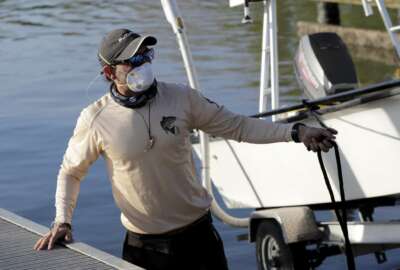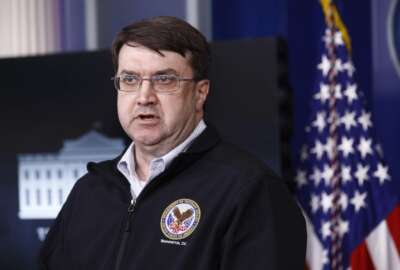
National Park advocates call for slow, controlled re-opening
A group that includes many National Park Service former employees and supporters is urging the Trump administration to go slow when it comes to reopening Americ...
Best listening experience is on Chrome, Firefox or Safari. Subscribe to Federal Drive’s daily audio interviews on Apple Podcasts or PodcastOne.
How widely and how fast the nation should reopen schools and businesses — it’s become a big debate of the day. A group that includes many National Park Service former employees and supporters is urging the Trump administration to go slow. The chair of the Coalition to Protect America’s National Parks, and a former NPS executive, Phil Francis joined Federal Drive with Tom Temin.
Interview transcript:
Tom Temin: Mr. Francis, good to have you on.
Phil Francis: Hi, thank you. Thank you for having me.
Tom Temin: And of course, as you know, above anyone, the national parks are visited and cherished by millions of people every year, but you’re urging going slow. Tell us what your concerns are, and maybe from the standpoint of park employees, what they face, should there be some sort of a rapid reopening?
Phil Francis: Sure, thank you, Tom. You know 327 million people visited the parks, I think last year or the year before, which are record numbers, and we now have 419 units of the national park system, and I think 49 states and also in the trust territories. So as we, as they – I used to be in the National Park Service so I continue to say we but they – have really a big job ahead of them in order to safely reopen the national parks and to make sure that park employees and volunteers and partners as well as the visiting public and gateway communities can all visit in a safe manner. Certainly one of the challenges is that the National Park Service’s budget has declined over the years. And as a consequence of that, we’ve lost thousands of employees. So at a time when we have record visitation and record number of parks, and now the coronavirus, our employees are really, while dedicated, extremely dedicated, are really challenged to be able to safely handle this upcoming visitors season. I’ll give you a good example. In parks like Grand Canyon or Yosemite National Park, there are lodges where seasonal employees reside during the summer season. And so just think about if you’ve got two people in a bedroom, and then you’ve got communal showers, and you’ve got a common area where employees might eat after hours, how do you keep those people safe? And how do you keep the visiting public safe when thousands of people are coming to the parks?
Tom Temin: Yes. You’ve pointed out that the frontline staff of the NPS are frequently in close contact with visitors.
Phil Francis: Oh, absolutely. Yeah. You know, the maintenance employees are constantly cleaning visitor facilities, making sure that they’re adequately cleaned often enough so that now, given the coronavirus, they’ve got a big cleaned much more frequently than they have been in the past. And so how can we do that with fewer people? How can we give interpretive walks to the visiting public and how do our emergency medical staff and the law enforcement staff interact with the public in a way that’s safe for both the public as well as our employees? So that we have adequate PPE, do we have adequate training? You know, if people feel like they are being put in an unsafe position, can they refuse to do whatever job it is that they may be facing? So it’s a big job. And so we should make sure, I think the National Park Service should make sure, that plans have been developed and that they are shared with all of us so that the public knows that when they come to a national park, they’ll have a safe visit.
Tom Temin: We’re speaking with Phil Francis, he’s chair of the Coalition to Protect America’s National Parks. And you’re citing in a document that the coalition put out – a document from NPS that says parks should estimate that 40% of the total population at the park will require isolation and 4% will require hospitalization. Tell us more about that.
Phil Francis: Yeah, well, that really jumped off the page, when I read that. To explain this, this is a planning document that the parks are using. So that if nothing happened, if business just sort of continued along the way, as it has in the past, you know that there’s a risk that 40% of the employees may become infected. So what the parks are now doing is they are trying to find a way to mitigate that risk, to lessen the probability that there’s going to be many infected employees. But if they’re unable to do so, are they still going to be required to open the national parks? I think not. I think that unless that it’s safe for our employees and safer visitors and safe for the gateway communities that surround the parks, then, you know, we’re going to have to keep the parks closed. So it’s really up the planning process now, seems to me, as to whether or not they can make the park safe.
Tom Temin: And what’s your sense of what’s going on in the NPS? Have you had contact with people there and do you feel like it looks as if adequate planning is taking place? And are they conferring with their employees?
Phil Francis: I know that planning is taking place. I do know that. And I do have a lot of respect for our active employees, as well as our retirees for that matter. But, you know, I don’t know what’s going to happen once the plans are developed. I don’t know how supportive the administration will be if the park suggests that they can’t open. There seems to be a lot of urgency associated with getting these parks open. And I understand the reason for that, and I understand the importance to the economy that our parks have. But I think that the safety of our employees and our volunteers, and all the people involved and operating or visiting apart, their safety is most important, and we need to do everything reasonably possible to make sure that people remain safe.
Tom Temin: And you’re advocating for letting the individual superintendents make those decisions at the ground level rather than having some sort of an edict from headquarters?
Phil Francis: That’s right. That’s exactly right. You know, I think the superintendents and the men and women are in the best position to make those decisions. Every park is a little bit different. Grand Canyon is a lot different than Gettysburg Battlefield. And so, you know, those superintendents and their staffs are in a good position to know whether or not they’ve got the wherewithal – the equipment, the supplies, the training enough people – to handle their particular situation, and they’re not gonna make a political decision. They’re gonna make a decision based upon good science. They’re gonna make a good decision based upon the health and safety of their employees and visitors.
Tom Temin: And the final question, you were superintendent of the park that includes the Blue Ridge Parkway, which is really long, and people think of that as a road. But is there more to it than just a road? Because you can see that should stay open because people drive through and what’s the big deal? But it’s – I think there’s more to it than the road isn’t there?
Phil Francis: Oh, there certainly is. It’s 469 miles long. We’ve got 4,000 neighbor, going through 29 counties. We got 20% of the tunnels in the entire national park system, incredible views, hiking trails, over 200 miles of trails, 14 visitor centers, and just to name a few things. And one of the great things about the parkway is the fact that you drive and enjoy these beautiful views. There’s picnic areas and camping, and then you can stop in some of the greatest communities in this country, you know, and have lunch or have dinner or maybe stay in a lodge. We’ve got lodging inside the park. It’s just one of the most wonderful parks that I ever worked on.
Tom Temin: Phil Francis is chair of the Coalition to Protect America’s National Parks. Thanks so much for joining me.
Phil Francis: Well, thank you Tom. I appreciate you having me.
Tom Temin: We’ll post this interview along with a link to the reopening criteria at www.FederalNewsNetwork.com/FederalDrive. Hear the Federal Drive on demand. Subscribe at Apple Podcasts or Podcastone.
Copyright © 2024 Federal News Network. All rights reserved. This website is not intended for users located within the European Economic Area.
Tom Temin is host of the Federal Drive and has been providing insight on federal technology and management issues for more than 30 years.
Follow @tteminWFED




